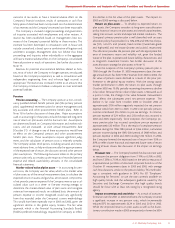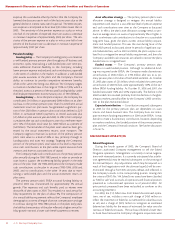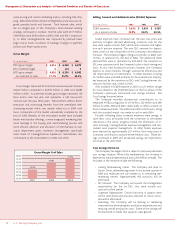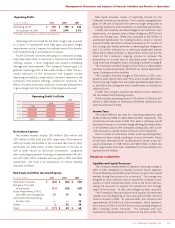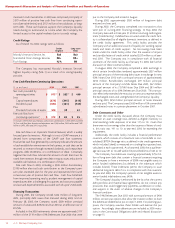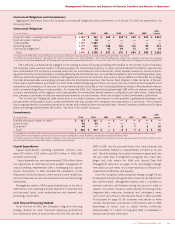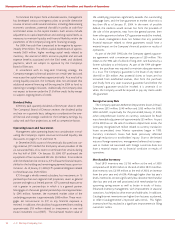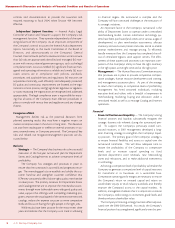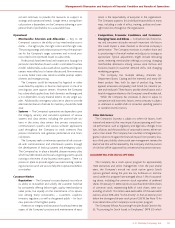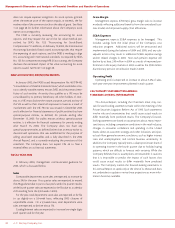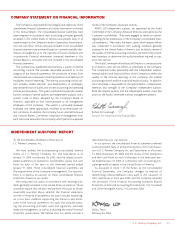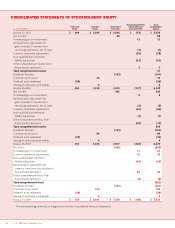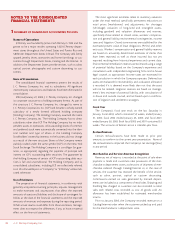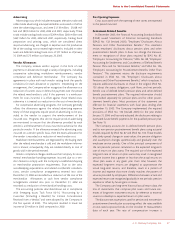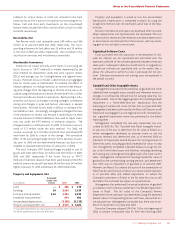JCPenney 2003 Annual Report Download - page 21
Download and view the complete annual report
Please find page 21 of the 2003 JCPenney annual report below. You can navigate through the pages in the report by either clicking on the pages listed below, or by using the keyword search tool below to find specific information within the annual report.
J. C. Penney Company, Inc. 19
Management’s Discussion and Analysis of Financial Condition and Results of Operations
od and continues to provide the resources to support its
strategic and operational needs. Longer term, a strong finan-
cial position is dependent on the Company achieving a com-
petitive level of profitability on a sustainable basis.
Operational
•Merchandise Selection and Allocation — Key to the
Company’s success is the ability to buy merchandise assort-
ments – the right styles, the right colors and the right sizes.
The pricing strategy and value proposition must be appropri-
ate for the Company’s target customers and in-stock posi-
tions need to be optimized based on sales trends.
Professionals have been hired with expertise in buying for a
particular merchandise division under a centralized business
model. Additionally, as discussed above, systems and logistics
centers were rolled out to better allocate and flow inventory
to stores, better track sales trends to enable prompt replen-
ishment and manage pricing.
The Company could be impacted by logistical or other
issues faced by suppliers, or have an interruption in one of its
own logistics store support centers. However, the Company
has a diversified supplier base, both domestic and foreign, and
is not dependent, to any material extent, on any single sup-
plier. Additionally, contingency plans are in place to provide
alternate distribution channels for inventory, should the need
arise.
•Systems — The Company’s operations are dependent upon
the integrity, security and consistent operation of various
systems and data centers, including the point-of-sale sys-
tems in the stores, data centers that process transactions,
communication systems and various software applications
used throughout the Company to track inventory flow,
process transactions and generate performance and finan-
cial reports.
The Company seeks to minimize operational risk associat-
ed with communication and information systems through
the development of back-up systems and emergency plans.
The Company has in place a detailed disaster recovery plan,
which has been tested, and focuses on getting systems up and
running in the event of any business interruption. There is a
process in place to provide regular associate training, operat-
ing instructions and site visits to help limit operational defects
or mistakes.
Consumer Market
•Reputation — The Company’s success depends not only on
its ability to re-establish and solidify the customer franchise
by consistently offering fashion-right, quality merchandise at
value prices, but equally on the maintenance of its reputa-
tion among many constituents – customers, suppliers,
investors, regulators, as well as the general public – for busi-
ness practices of the highest quality.
Attention to integrity and reputation has always been a key
aspect of the Company’s practices and maintenance of repu-
tation is the responsibility of everyone in the organization.
The Company supports this individual responsibility in many
ways, including a code of ethics, training, policies and over-
sight functions throughout the organization.
•Competition, Economic Conditions and Customers’
Changing Tastes and Values —Competitive risk, the econo-
my and consumer attitudes are each important risk factors
that could impact a retail channel’s or the entire Company’s
performance. The Company monitors its market share and
its positioning in the retail market and adjusts its strategy as
appropriate. Typical adjustments might include relocating
stores, reviewing merchandise offerings or pricing, changing
merchandise allocations among various store formats and
locations based on customer demand shifts, and changing
marketing programs.
The Company has multiple delivery channels (i.e.,
Department Stores, Catalog and the Internet), and many dif-
ferent product lines, both by type of product (e.g., home,
apparel, accessories and jewelry) and brand (i.e., national, pri-
vate and exclusive). These factors provide diversification and a
level of mitigation relative to the Company’s overall market risk.
While the Company has processes in place to adjust to
competitive and economic factors, every company is subject
to unknown or sudden shifts in consumer spending patterns
or overall economic factors.
Other Risk Factors
The Company’s business is subject to other risk factors, both
internal and external, that may impact future operating and finan-
cial performance, such as regulatory and legal risks, changes in tax
laws, inflation, and the possibility of catastrophic events, either nat-
ural or man-made. The Company has a number of integrated pro-
grams in place to mitigate the financial impact from property loss-
es or third-party liability claims; each year management reviews the
level of risk that will be retained by the Company and the portion
of risk that will be supported by conventional insurance contracts.
ACCOUNTING FOR STOCK OPTIONS
The Company has a stock option program for approximately
1,500 executives and senior management. Over the past several
years, the Company’s annual net stock option grants (stock
options granted during the year, less any forfeitures or termina-
tions) under this program have averaged about 1.5% of outstand-
ing shares, including the common stock equivalent of preferred
shares. On January 31, 2004, options to purchase 24.5 million shares
of common stock, representing 8.6% of total shares, were out-
standing, of which 17.6 million were exercisable. Of the exercisable
options, about 56% were “in-the-money” or had an exercise price
below the closing end-of-year stock price of $26.18. See Note 13 for
more details about the Company's stock option program.
The Company follows Accounting Principles Board Opinion No.
25, “Accounting for Stock Issued to Employees,” (APB 25) which


